TOG - British heavy tank since the beginning of World War II.
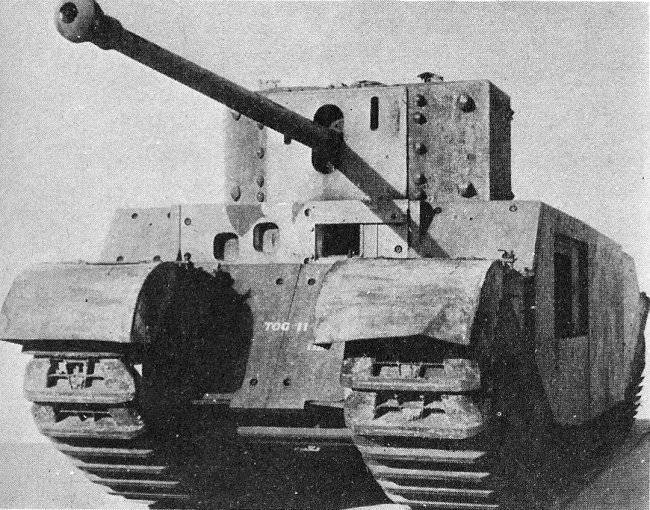
Even before the start of the Second World War, it became clear that the multi-tower scheme had ceased to be relevant. Tanks like the T-35 or A1-1, in the presence of a large number of barrels, had subtle reservations, and therefore could not play the role of "infantry". At the same time, the creation of a fundamentally new machine did not want to allocate time and spend money. From this it was concluded that the Tank Corps needs an analogue of the Mk.VIII “Liberty”, but performed at a new level.
Requirements for a new tank for use in hostilities in Europe were discussed in July 1939. The Minister of Supply of Great Britain and Sir Albert Stern, who during the years of the First World War headed the Department of Supply of Tanks, took part in the discussion. Ser Albert Stern in British tank design was a legend. As secretary of the First Ground Ships Committee in the World, it was he who in many ways organized mass production of tanks in the UK. Sir Albert had not only extremely great authority, but even more self-esteem, which in this work played a negative role.
Probably, both the Minister of Supply and Sir Albert assumed that the German army would certainly be struck along the “Maginot Line”, which would make it possible to withstand a long siege. Namely, the experience of senior comrades is useful here. As a result, 5 of September was offered to Sir Albert Stern to form a committee and work out jointly with tank specialists the requirements for a heavy tank. The committee included Sir Y. Tennison D'Encourt, Major Walter Wilson, Mr. Ricardo and General Swinton. In addition, Stern made an offer to Sir William Triton of Foster to assist in the development of a new tank. In 1914-1918, these people were directly involved in the design and construction of "lozenges", whose running gear was best suited for overcoming field barriers and ditches. Given that the committee included veterans of tank building he was given the informal nickname The Old Gang (Old Gang, TOG).
Soon the committee asked the General Staff of the British Army to issue demands for a heavy tank in response to which they offered to visit France to familiarize themselves with the design of the allied tanks. In addition, it was supposed to learn the opinion of the officers of the headquarters of the expeditionary corps of Great Britain. Obviously, the desire of the military with the opinion of the committee on the form of a new heavy tank was not very different. As an example, could serve as a French tank B1bis, which possessed all the necessary qualities, with the exception of strong weapons. However, the layout of B1bis repeated those. solutions of late "diamonds", in front of the body of which the installation of a powerful tool was planned. As a result, the orthodox tank builders decided to combine the new and the old, thus outstripping their allies.
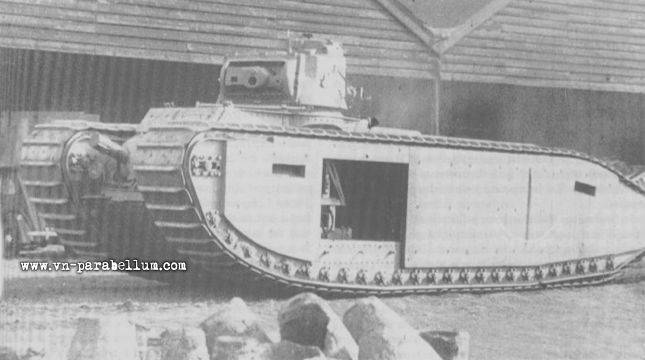
In October, a committee called 1939, officially called the Committee for the Development of a Special Machine of the Ministry of Supply, finally received a full-fledged technical task. The design of the new heavy tank provided for an elongated body. The mover was supposed to use the tracks, completely covering the body in length and height. The hull reservation was supposed to withstand a 91 meter (100 yards) from an 37 mm caliber anti-tank cannon and 105 mm howitzer field shells from 40. The armament of the tank was conditionally divided into two types: a gun mounted in the front hull sheet and intended to destroy field fortifications; two 7,92 mm guns and two BESA 8 mm machine guns mounted in the airborne sponsons for stripping enemy trenches. The speed of the tank was limited to 5 km \ h (82 miles \ h), with a cruising range of no more than 50 km (XNUMX miles). Such low performance was due to the concept of "infantry tank" - the military believed that this type of vehicle should not "run away" from the infantry. For the delivery of tanks to the leading edge of the front would like to use rail transport.
Wanting to play it safe, the military department issued TTZ to two companies at once - Foster and Harland & Wollf. The committee worked on the side of Foster. They decided to apply the abbreviation TOG to the tank, although the designation TOG1 (TOG # 1) was also used. In addition, the terms of reference provided for the use of a diesel engine.
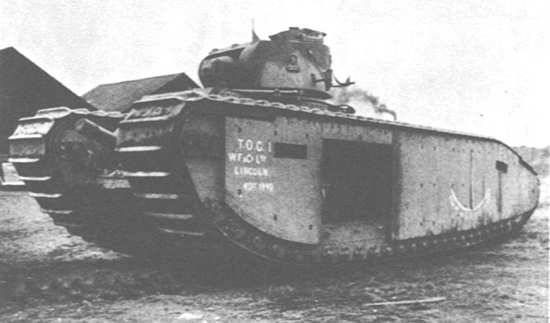
Thus, the draft design of a heavy tank TOG presented in December 1939 combined advanced technical ideas and clear anachronisms. The “old gang” has developed a multi-roll undercarriage with a rigid suspension without elastic elements. This simplified the design and reduced the weight, but despite this, the design weight of the tank without sponsons, weapons, ammunition was 50 tons, and the diesel engine of the appropriate power has not yet been created. Instead, it was suggested to use the 600-cylinder V-shaped diesel engine Pacsman-Ricardo (power 12 hp) forced to 450 HP. According to the project, the crew of the tank were 8 people: the commander of the machine, the driver, the gunner and the loader of the front gun, as well as four tankers in the sponsons.
Already at this design stage, two miscalculations have become apparent. First of all, it concerned the armament. The applied scheme no longer corresponded to the realities of warfare. Onboard sponsons were removed, and on the roof of the hull they demolished a circular rotation tower. The second significant problem was the transmission. The scheme with a planetary mechanism proposed by Wilson, given the mass of the tank, was unacceptable. Arthur Stern insisted on using an electromechanical transmission in the car. Back in 1916, he unsuccessfully tried to introduce this scheme to the first tanks, but only now it was possible to implement this idea. To work attracted the company English Electric Company, which developed the electrical transmission of the original scheme. On TOG, the engine rotated an electric generator, which served to power two onboard engines. The steering wheel was associated with a potentiometer that varied the voltage on the onboard electric motors. The rotation of the machine was carried out due to the difference in the speed of rotation of the tracks.
In February, 1940, the revised project was accepted for implementation. A wooden model was made and some units were ordered. Design at first sight struck archaic. The design was narrow, tall, long and awkward. She largely repeated the concept of early tanks. The diamond shape of the hull, tracks made of nickel steel and machine gun sponsors on the sides only exacerbated the archaic. Foster completed the assembly of the first prototype in October. The developers were able to meet the “dry” tons in the 50, however, there were still cutouts for sponsors in the case. On the roof mounted tower from the infantry tank «Matilda II». Armament TOG1 consisted of 75-millimeter guns in the front hull sheet and 40-millimeter gun paired with 7,92-millimeter machine gun in the turret. To compensate for the increased load on the ground, a wide tracked track was introduced. The armor was supposed to withstand the hit of armor-piercing projectiles of caliber 47 mm, however in the subsequent thickness they were constantly revised. The side armor on the prototype had a thickness of 65 mm.
The tests of the prototype of the TOG tank, which began on September 27, were difficult and lasted for quite some time. November 6 tank shows to representatives of the MoF (Ministry of Supply, Ministry of Supply) and the army. The weight of the tank without sponsons with the Matilda II turret was 64555 kg. During testing, the power plant was constantly overheating, and it was not possible to eliminate this problem. In the end, the engine and transmission are out of order. Another problem was the low adaptation of the transmission design. During transmission operation, the guide wheels and tracks were deformed.
At the same time, the ministry quite satisfied the TOG heavy tank in terms of its main driving characteristics. The main test cycle was completed in June 1941, but MoF insisted on continuing the work.
To correct the identified deficiencies, a hydraulic transmission was installed on the prototype, the work on which continued for two years, after which the car was given the designation TOG 1А. New equipment was manufactured by Hydraulic Coupling and Engineering Company. Management of this modification was unreliable due to the large inertia of hydraulic couples. Despite this, in May 1943 began to test with a hydraulic drive, but a month later the car was returned to the factory for further improvements. The latest information regarding TOG 1A dates back to April-May 1944, when the prototype passed another series of tests. After that, the tank was sent to Chobham on the 100-ton Pickford transporter, where his tracks were lost.
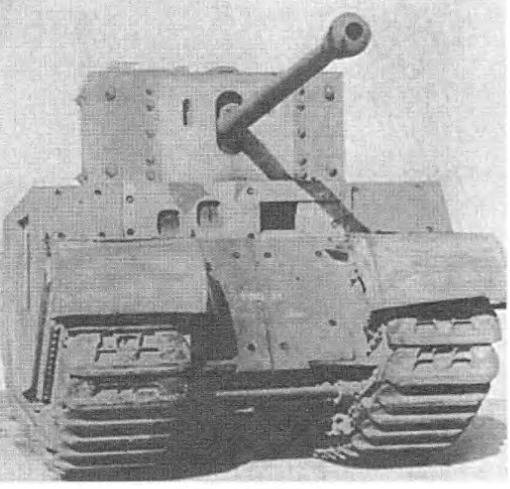
The capitulation of France marked the end of the positional war on the Western Front and the need for such a tank was no longer necessary. However, under the influence of some officials, among whom there was Winston Churchill, the work on the TOG continued. 6 May 1940 was issued an order for a modified prototype which received the designation TOG 2 (TOG No. 2). It is not exactly known why a new TOG design was required at an early stage of development, but most likely this decision was related to armament.
To improve the technical performance required radical measures, mainly aimed at reducing the weight of the tank TOG 2. The mechanics were identical to the predecessor, and the apparent difference was in the tracks. Trucks since the First World War remained unchanged, and the spring-loaded suspension did not appear. The hull was redone in such a way that the upper branch of the caterpillar fell into the tunnel, passing the rear drive wheel, went forward and hit the front sloth at the exit of the tunnel. The caterpillar was lowered into the tunnel to expand the hull under the shoulder strap of a larger tower. The gun in the front hull sheet was dismantled. Now the main armament - an 57 mm caliber gun - was to be mounted in the tower of a new design. Guns and machine guns remained in the sponsons, but the sponsons themselves were not installed. However, it was not possible to immediately get the tower, so it was temporarily replaced by a wooden model that has a simpler form with a fake gun. Diesel-electric transmission, despite its overheating, saved. According to the remaining records, cast iron side sheets of thick 63 mm were installed on the layout.
The drive for the two main generators served as a diesel engine mechanically connected with them.
Generators fed electric motors on each side. To change the speed of movement of the tank served as a diesel engine fuel pedal. An additional speed control was provided by a manual lever for changing the resistance of the current feeding the generator and the electric motor. By turning the rudder connected with the potentiometer in the excitation windings of the generators, the current resistance was changed. As a result of turning the steering wheel to one of the sides, the output power of the electric motor located on the opposite side of the motor increased due to the increase in voltage in its windings. Another electric motor, powered by its generator, transmitted power to the drive wheel of the other side, thus helping to make a turn. This was one of the ways of independent reversing one of the engines and turning the tank around its axis. The rotation of the machine with a radius equal to its width was carried out by braking one of the tracks with pneumatic brakes.
The first factory "jogging" prototype tank TOG 2 made 16 March 1941 g. Further tests did not reveal any special observations, but the time was lost. The maximum speed of the tank was 14 km / h, and the cruising range to 112 km. The chassis TOG 2 allowed the car to overcome the ditch width 6,4 m and vertical walls height 2,1 m.
In September, 1941 made significant changes to the design of the tank, and assigned the TOG 2 * index to the vehicle itself. The gun in the frontal list and the side sponos were removed, and the reservation was revised. The main gear was also continued to be reworked, but most importantly, they decided to fix the torsion bar suspension on the tank, however, until April 1943 did not implement it. Work on the TOG 2 * was delayed, and the requirements of the battle quickly changed. In this regard, the designers decided to install in the tower 17-pound gun, developed by Messrs Stothert and Pit. In 1944, this tower was installed on the A30 Challenger.
The 1943 tests, which began in April, confirmed that the TOG 2 * is the heaviest (over 81 tons) and the most powerful British tank, but the concept used in its construction has long been outdated. Even despite its booking, the TOG was inferior in armament and dynamic qualities to the German Pz.Kpfw.IV with a long-barreled cannon of the 75 mm caliber, not to mention the Tiger and other more powerful tanks. The war of maneuver for TOG was disastrous.
Despite this, in 1942, the design of the TOG 2R modification began (R-revised index, revised). It was assumed that the new car due to the refusal of sponsons will reduce the length of the chassis, while maintaining the torsion bar suspension, an electric tower equipped with 76,2 caliber mm. A further development of the heavy infantry tank was the TOG 3 project. However, both of these projects were never implemented. TOG was originally designed for the war, which ended 20 years ago. The old gang wanting to repeat their triumph in the TOG essentially created a car for the First World War. The fact that the epic with TOG was delayed until the 1944 of the year speaks of the personal collapse of Stern and the Old Gang, and that instead of developing the tanks really necessary for Britain, many engineers were engaged in the initial nonsense throughout the war.
The fate of the TOG 2 * tank, unlike the TOG 1A, turned out to be happier. After the war, he was sent to the warehouse. Soon it was removed from there, repairs were carried out and transferred to the Bovington Armored Museum. It should be noted that the Paxman “native” engine remained on it, although the car was not on the move.
Performance characteristics of heavy infantry tanks TOG / TOG 2 *:
Combat weight - 64555 / 81284 kg;
8 crew (for the project) / 6 people;
Dimensions:
Length - 10130 mm;
Width - 3120 mm;
Height - mm 3050;
Armament: gun in the 75 caliber case, two 40 caliber mm guns in the sponsors, 2 4 machine gun of the BESA machine gun of mm (project) / XQUMX ONFXNXXpdr machine gun of the caliber of 7,92 mm and BESA machine gun of the 17 mm gun;
Aiming devices - telescopic and optical sights;
Booking:
Forehead and hull board - 62 mm;
Bottom - 12 mm;
Roof - mm xnumx;
side turret - 62 mm / 40 mm;
Front of the tower - 62 mm / 63 mm;
Engine - Packsman-Ricardo 12TP, 12-cylinder, diesel, liquid cooling, hp 600;
Transmission - electric type;
Chassis (one side) - rear drive and front guide wheel, 24 track rollers;
Average technical speed - 6 km / h;
Maximum speed - 12 km \ h \ 14 km \ h;
Cruising on the highway - 80 \ 112 km;
Height overcome walls - 2,10 m;
Wing width - 6,40 m.
Based on materials:
http://vn-parabellum.com
http://alternathistory.org.ua
http://panzer-journal.ru
http://www.thetankmaster.com
http://warportal.ru
- Peter Ulyakin
- http://panzer-journal.ru,
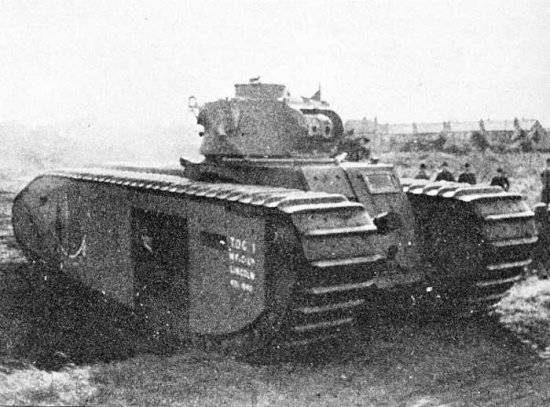
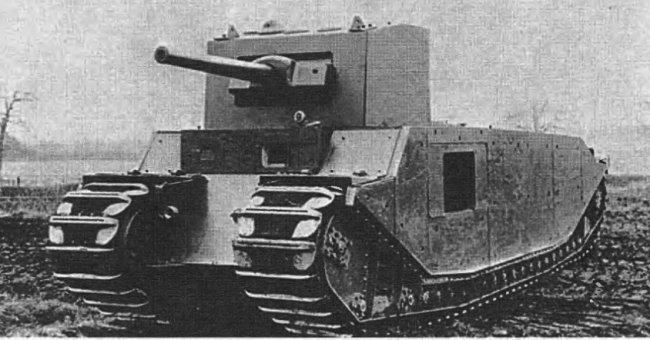
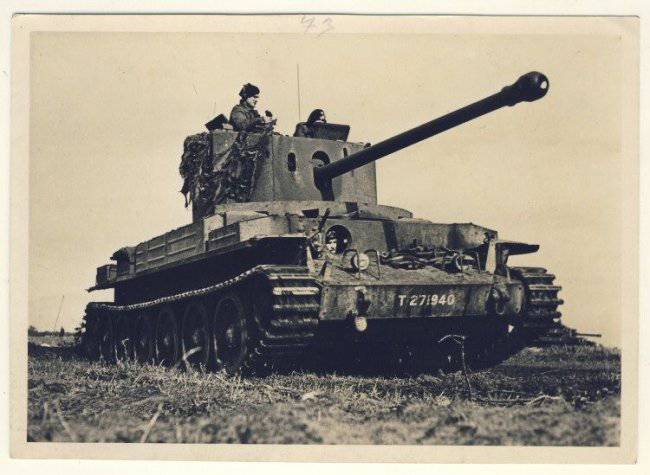
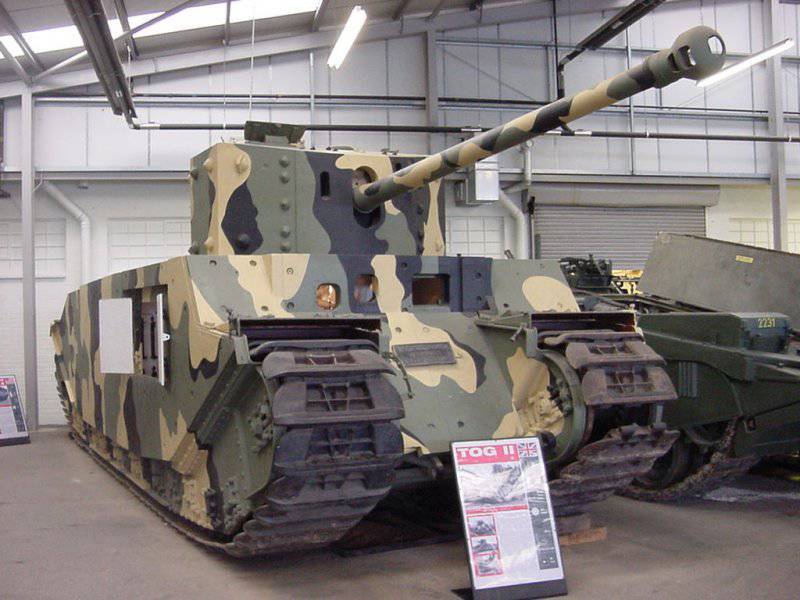
Information